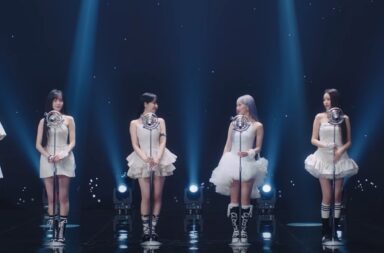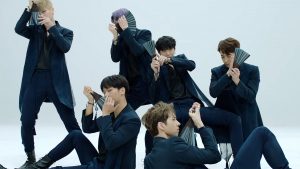 When thinking of VIXX, it’s hard to separate them from concepts. Whether it’s pulling from classical Western literary characters and archetypes or pushing the boundaries of K-pop into genres like gothic horror and sci-fi, they’ve steadfastly held on to their niche as concept-dols. The surprise or shock value of earlier concepts and VIXX’s dedication to bringing these concepts to life were crucial in putting the group on the saturated map of K-pop.
When thinking of VIXX, it’s hard to separate them from concepts. Whether it’s pulling from classical Western literary characters and archetypes or pushing the boundaries of K-pop into genres like gothic horror and sci-fi, they’ve steadfastly held on to their niche as concept-dols. The surprise or shock value of earlier concepts and VIXX’s dedication to bringing these concepts to life were crucial in putting the group on the saturated map of K-pop.
But as much as this niche offers many possibilities and unexpected manifestations, continued heavy-handed use of concepts could not be sustainable, as it threatens to overwhelm the music and performance aspects. A better balance had to be attained as VIXX’s career unfolded. This slowly took shape with the Conception trilogy, which drew on Greek mythology but used the literary influence in a subtle manner. Gone were the heavy makeup and styling of earlier eras; the MVs in the trilogy were rich in colour and texture, but had an overall sleeker, cleaner look. Complex as the narrative was, the aesthetics took a step back to allow the music and dance to take centre stage.
“Shangri-La” follows up with this balanced approach, with an exception — there is no apparent narrative here, not even a vague hint of a plot point like “Chained Up” had. The Korean title of the song references Peach Blossom Spring, a fictional earthly paradise depicted in the preface of poet Tao Yuan Ming‘s Peach Blossom Spring Poems.
 The preface tells the tale of a fisherman who stumbles upon a forest comprising solely of peach blossom trees while rowing along a stream. At the end of the forest is the stream’s source and a mountain with a small opening, leading to a peaceful, utopian community of people whose ancestors had taken refuge there during the Qin dynasty wartime. As he departs, the fisherman leaves a trail, but he never manages to find Peach Blossom Spring again.
The preface tells the tale of a fisherman who stumbles upon a forest comprising solely of peach blossom trees while rowing along a stream. At the end of the forest is the stream’s source and a mountain with a small opening, leading to a peaceful, utopian community of people whose ancestors had taken refuge there during the Qin dynasty wartime. As he departs, the fisherman leaves a trail, but he never manages to find Peach Blossom Spring again.
As a song, “Shangri-La” is only tangentially connected to its source material. Instead of being a literal place, Peach Blossom Spring becomes a metaphor for the persona’s lovestruck emotional state:
Gorgeously blossoming flowers
Even the wind is sweet
In this dream-like place
Whenever I’m with you
Wherever it is, my heart flutters
The pathetic fallacy in the opening lines extend through the rest of the song: “Even unripe peaches taste sweet / Under the scattering flower petals / Following the tip of your silk clothes”. The petals here may not be literal, but rather are expressive of the charm that the persona’s lover exudes.
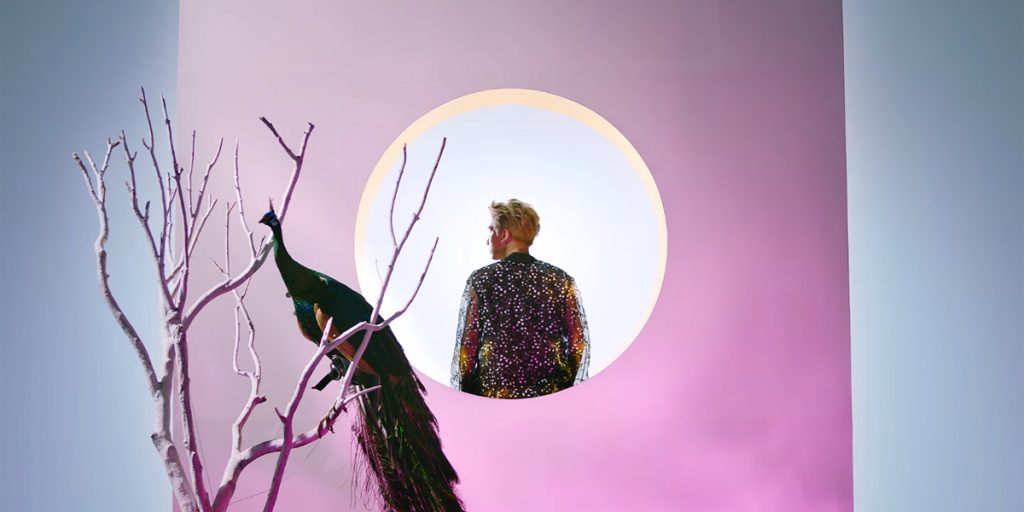
The song has subtle but discernable elements of Chinese orchestral music, blending a pared-down electronic synth instrumental with vibratos played on the guzheng. The Chinese aesthetics take on a similarly subtle form in the styling, and is mixed with contemporary elements. The members are often dressed in silky clothing with sashes characteristic of Chinese dance costumes, but the solid colours give these outfits a modern, sharp look.
The accessories, like the fans and a tasselled ornament (this can be seen hanging from Ravi’s sash at the 1:47 mark), are also given a twist to look contemporary. Fans used in Chinese dances are typically brightly coloured, but VIXX uses single-coloured ones in a muted blue-grey shade. Likewise, the dance—by Mariel Madrid and Keone Madrid—is a fusion of Chinese dance and modern dance, with the moves of the chorus featuring an R&B style.
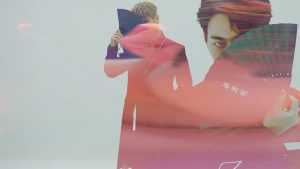
The MV is also covert in its incorporation of Chinese aesthetic elements. Hyuk rests against a round window, a feature characteristic of, though not exclusive to, Chinese architecture. Also part of this set is a peacock, a bird that is often portrayed with peonies in Chinese paintings to symbolise prosperity. The small pine trees that Ravi and Ken can be seen with are also a common subject of Chinese art. These touches are included not for deeper symbolic meaning, unlike the plum blossom in Sistar‘s “I Like That”, but rather to create a sense of the style and culture this release draws from.
But the set and prop choices are not simply plucked at random just to create hints of Chinese aesthetics; they also respond to details in the lyrics and the Peach Blossom Spring tale. The presence of water is a nod to the stream in the tale, while the circle motif and window ties in with the image of the white moon in the lyrics. The doorway that Ken sits in is a possible allusion to the opening in the mountain that leads to Peach Blossom Spring, which is described as just big enough for one person to pass through. The silver peach that Hongbin plucks and Hyuk drops is a visualisation of the unripe peach that still tastes sweet to the persona because he is enchanted by his lover.
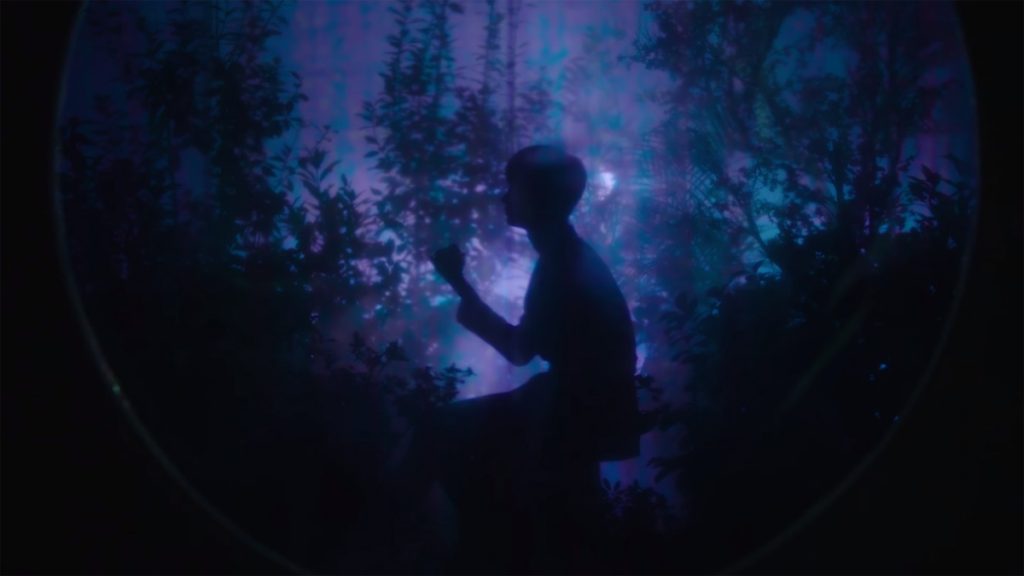
These elements are placed together in a minimalist, exhibition-room-like space, with each member occupying an individual set. This could have easily felt fragmented or cold, but the disparate sets are transformed through the use of jewel-toned lighting and clever camerawork into a sensual, dynamic whole. Pull-back shots are joined to tracking shots (such as the second shot of Hyuk with the deer and the silhouette of N in a forest, 2:32), and movement within the shot is often juxtaposed against the camera moving in a different direction, like a white ink-cloud billowing downwards and the camera tracking towards Ken (2:13). The attention paid to such details is what makes “Shangri-La” stand out from the typical MV that splices choreography sequences between individual shots.
The dynamism of the MV is sealed by an aura of fantasy. This is created by surreal shots like the close-up of Ken’s hand reaching for a flower, warped visually due to being seen through the cylinder of water, or the superimposition of a pink-tinted shot of rippling water onto the shot of Hyuk and Hongbin with fans.
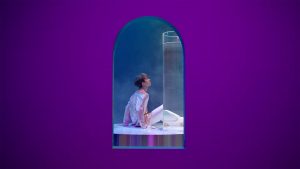
Through combining lush colours, sharp silhouettes, subtle Chinese aesthetic influences, and an abstract but evocative fantasy setting, “Shangri-La” somehow manages to keep an undercurrent of the dark edge that is a signature of VIXX’s MVs, but reworks this in a sensual direction rather than a Gothic horror one. It has a subdued quality, but retains a sense of richness, allowing its visual concept to both rest on and bolster the song and its theme. It’s an incredibly well-crafted release that takes VIXX to greater heights of artistic maturity even as it stays true to their focus on concepts.
MV Rating: 4.1/5
(YouTube, Lyrics via pop!gasa, Images via Jellyfish Entertainment. Wikipedia China.)
